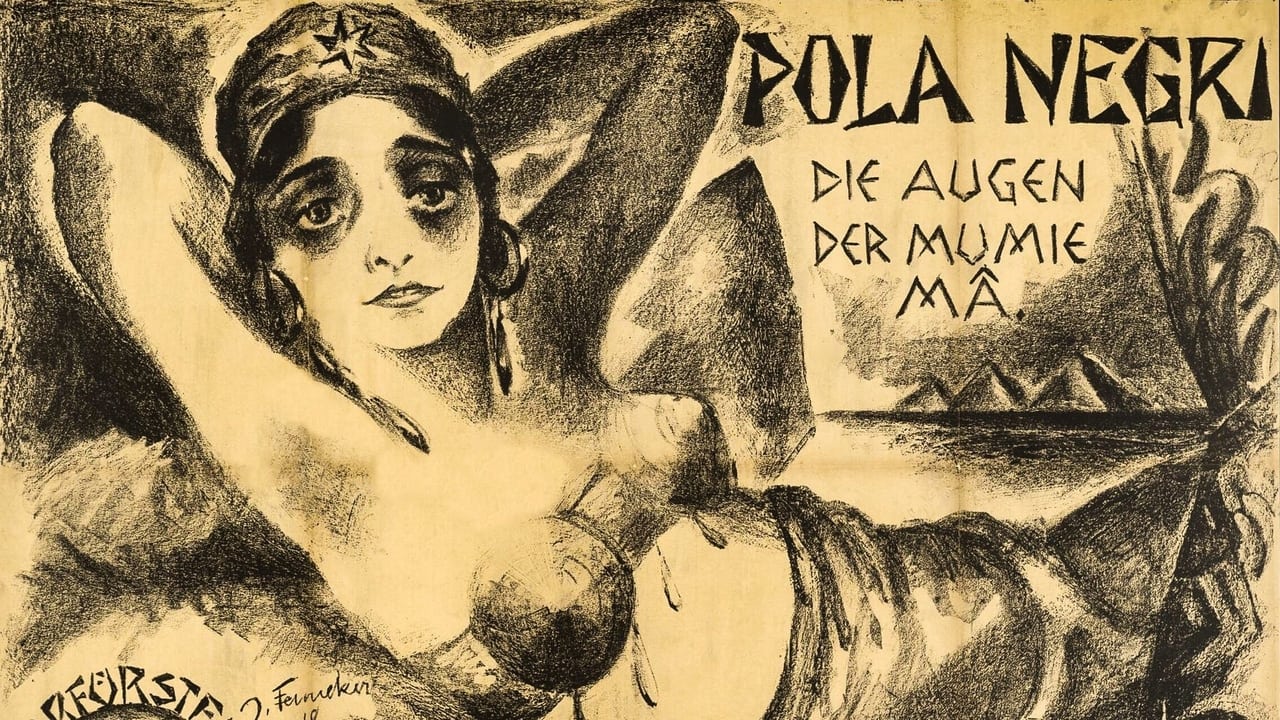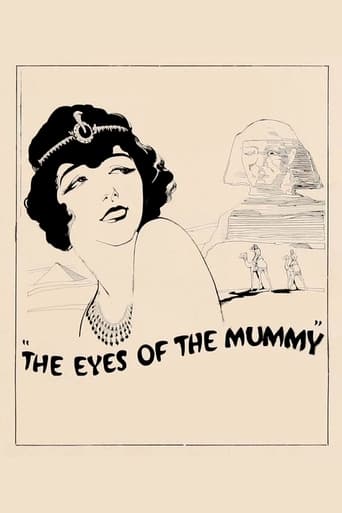

Tied for the best movie I have ever seen
... View MoreThe greatest movie ever made..!
... View MoreLet's be realistic.
... View MoreVery interesting film. Was caught on the premise when seeing the trailer but unsure as to what the outcome would be for the showing. As it turns out, it was a very good film.
... View MoreIn the late 1910s, while Hollywood was focusing mostly on serious contemporary drama, their soon-to-be significant rivals in Berlin were turning more towards adventuresome flights of fancy. Myth, fantasy, exotic lands and a touch of horror were the hallmarks of German cinema. Although better known for his unique comedies, director Ernst Lubitsch was nevertheless a capable and versatile craftsman, and at this stage was at the forefront of the Germanic style.The approach to these pictures was all about space, and for Lubitsch the most important aspect of space appears to be depth. A lot of the movement in Die Augen der Mumie Ma is towards or away from the camera. Of course, Griffith and many others in the US had been doing this for years, but Lubitsch actually shuns horizontal movement, and his pictures seem designed to accommodate movement in depth. Often there is a large empty space behind the actors, or a doorway at the back of the set leading to another room. The bric-a-brac of Kurt Richter's elaborate set design tends to be concentrated at the sides of the frame, creating a kind of tunnel effect in some scenes.What is the point of all this? Well, I think first and foremost it was probably just a style that appealed aesthetically to Lubitsch and Richter, and there is no shame in that. Nevertheless it is one that they could use to great effect. Emil Jannings often appears to be advancing eerily upon us, while good guys Harry Liedtke and Pola Negri disappear worryingly away from us. In the few shots where the actors are backed up against a wall with no space behind them, for example in the flashback where Jannings first brings Negri to the tomb, the sudden change is palpable, in a nastily claustrophobic way. And depth plays a part in all the most chilling moments, such as Jannings appearing in a mirror at the far end of the room. We simultaneously see him in the distance yet are aware he is actually behind the camera, and thus behind "us". These are all moves towards a more interactive cinema, in which the audience are not merely external observers, but feel they are enveloped in the film's world.Die Augen der Mumie Ma is also notable for early performances by two giant figures of German cinema, the aforementioned Emil Jannings and Pola Negri. Like Lubitsch, Jannings's area of expertise was comedy, and his Radu is a hammy caricature. But Jannings's hamming was of a good sort, and just as his excessive mannerisms could make us laugh in pictures like The Merry Jail or Faust, here they come across as grimly macabre. Negri too is a little hysterical at times, but in fact far less so than many leading ladies of German cinema, and most of her performance is refreshingly restrained, comprised of slow, delicate movements.If there is anything significantly wrong with this picture, it is its naïve silliness. For example, Jannings is taken to Europe to become Hohenfels's manservant, and yet still potters about the prince's palace in his native garb, clutching his dagger and muttering about getting revenge on the woman who wronged him, whereupon the prince pats him amiably on the shoulder as if to say "There, there old chap". Mind you, it would probably have looked equally ridiculous had the murderous Radu been given a haircut and shoehorned into a butler's uniform. Such moments are an unintentional source of humour for me, so I don't regard them as so much of a bad thing. It goes without saying that screenwriter Hans Kraly was another collaborator on this picture whose main field was comedy, and he was most adept at creating romantic fables for fast-paced farces, a genre that doesn't exactly demand logic and cohesion. And yet, in the hands of Lubitsch, Jannings and Negri, Die Augen der Mumie Ma becomes an atmospheric and reasonably entertaining short horror adventure.
... View MoreHere are Lubitsch, Pola Negri and Emil Jannings back in the year 1918 at the start and before they achieved their huge fame. Of course, this is a low budget movie. The Egyptian desert scenes were filmed in a Berlin quarry and the Egyptian tomb is of absurdly cheap quality. However we can see the evident skill of Lubitsch when working with his lead actors. The fascinating personality of Pola Negri shines . I certainly wish that we had more such real women in today,s modern movies. So please enjoy this nostalgic movie. Consider that if it was remade today with millions of dollars, special effects and huge publicity ,that it might be a box-office bonanza
... View MoreAs a piece of movie entertainment, Eyes of the Mummy is dated and unremarkable seen through current standards. There are a few nicely nightmarish moments (especially a scene when Ma sees Radu in the mirror while nobody else seems to notice) but overall, this is no Cabinet of Dr. Caligari.On the other hand, fans of cartoonist/writer Edward Gorey will be richly rewarded by a film that appears to have been designed and directed by the illustrator of "The Gilded Bat" and "The Blue Aspic." The effect is uncanny and curiously involving. It's not just the melodramatic subject matter...every detail has the Gorey touch. One almost imagines the hand-drawn texture lines. Any Gorey fan will find Eyes of the Mummy to be well worth the time spent.
... View MoreThis 1918 film directed by the great Ernst Lubitsch is alleged to be the first mummy horror film although there is a claim of a lost 1905 film. The only problem is that except for the title there is no mummy! The plot, well here goes. An art student in Egypt goes to an Egyptian tomb to find Ma who may possibly be Pola Negri. I say possibly because the player of the lead character is NOT identified in the credits. Ma is being held as a slave by an Arab (beautifully over acted by Emil Jannings) who is beaten up by the student who then liberates Ma and takes her back to Germany. The Arab nearly dies in the desert but is rescued by a German prince to whom he swears to serve for life. He, the Arab, is then also taken to Germany. Ma in the meantime wows them with a hootchie kootchie dance at a party and gets a theatrical contract to perform on stage. The exotic dance is a hoot. Meanwhile Ma's former Arab master comes across her and in a fit of revenge kills her. The end and all in 30 minutes and no mummy. The overacting in terms of gestures common to silent films of the period is quite present. Jannings, in semi black face, is quite effective as the villain. His repertoire of sinister facial expressions is quite large. All in all the film is an historical curiosity that I am sure Lubitsch and Negri tried to forget when they became more well known.
... View More